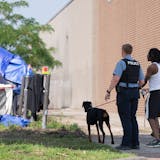How does a house become a set? When the play is "A Christmas Carol: A Ghost Story" and the house is the James J. Hill House, built five decades after Charles Dickens' novel was published, it's not hard.
Three groups of 30 will make their way through the 1891 home at staggered times each evening for the 90-minute show. That means there will be three Scrooges, three Bob Cratchits, three stage managers, etc. There are rules — no red wine, no touching the woodwork, no flash photography — but Wayward Theatre's hope is that moving through a 42-room Victorian mansion will capture the atmosphere of Dickens' tale, which debuted in 1843.
"It steals the show, most of the time. This is our fourth show in that space, so we welcome having the house kind of be another character," said director Sarah Nargang. "There is an intimacy you achieve when you enter a room and silence falls before you begin to tell the story."
Still working back to prepandemic levels of 42,000 annual visitors, Hill House site manager Betsy Faber said that plays introduce newcomers to its splendors and make it feel like a home again, at least for the length of a performance.
There are a couple of introductory spaces but the ghostly action begins on the third floor, where miserly Ebenezer Scrooge, who has forgotten the meaning of Christmas, awakens to encounter one of four phantoms who acquaint him with the holiday's spirit of generosity and joy.
Scrooge's bedroom (James Norman Hill's room)
James N. and Louis Hill were at Yale when their parents moved in, according to Faber, but they had bedrooms, anyway. And bathrooms.
"Guides like to point out that this is one of the few bathrooms that remains historically accurate," said Faber.

